“CROONING” IS A WORD THAT DOES NOT DO JUSTICE TO AL BOWLLY. HIS VOICE CONTAINED A REAL SENSE OF ARTISTRY, POWER AND ORIGINALITY, IN ADDITION HE HAD A GIFT OF INJECTING REAL MEANING INTO THE MOST BANAL OF LYRICS …
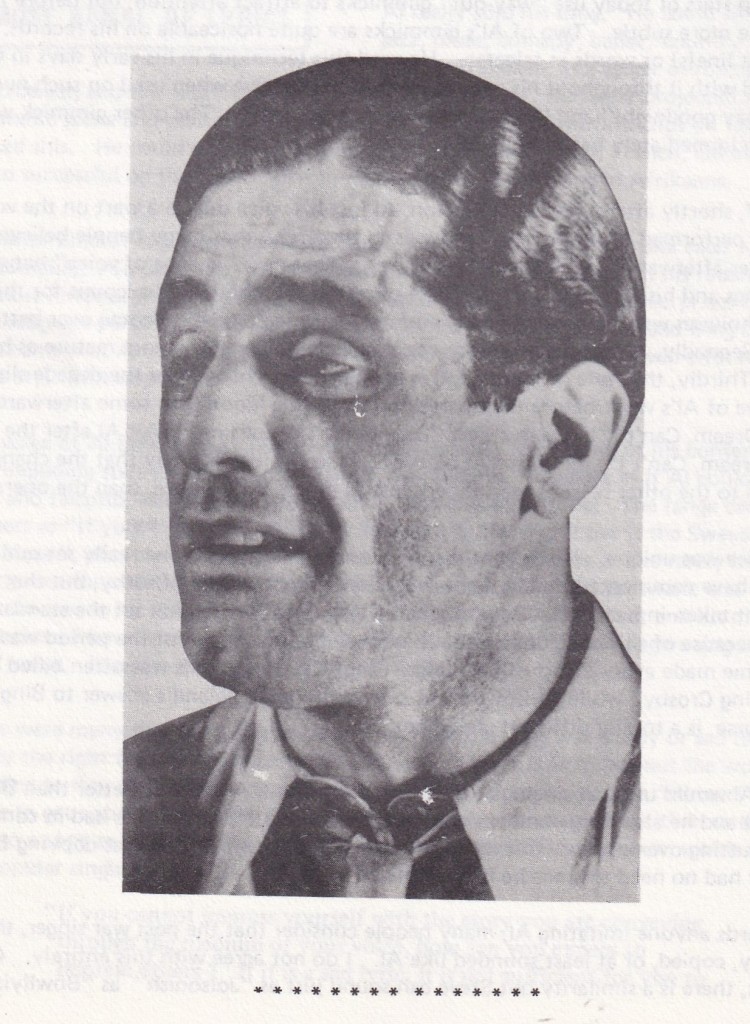
Al Bowlly was always anxious to please whoever he was working for. He took great care to ensure he put over a number correctly. He even used a dictionary to help him get pronunciation correct. Al really sold his song. He could sing anything, jazz, blues, comedy, ballet,. country and ballads. It was, of course, as a singer of romantic songs that Al really excelled, and this was the way he won his reputation. He really projected a song with strong dramatic scene and gestures. Those who have seen any of his film clips on television would have noticed this. He could sing in several languages including Dutch, French, German and Yiddish .He was also successful on the South African market being able to sing in Afrikaans.
Whatever kind of treatment a song required, Al could provide and make each type of song seem his speciality. To illustrate this, one need only play a cross section of his records. Al recorded most kinds of material with the exception of sacred music. This surprises me since Al was a very religious person .Other singers of the day such as Sam Browne and Bing Crosby did and it is a shame that Al didn’t as he could have put over such material so well with his intimate and sincere style of delivery.
The voice of Al Bowlly has a remarkable range, greater than many of his contemporaries or successors including stars like Bing Crosby and Frank Sinatra . It seems as if Al could sing baritone tenor, alto and falsetto, although he was generally billed as a baritone. The range can be heard on such numbers as “If you’ll say ‘yes’, Cherie”, “Maria, My Own”, “Love is the Sweetest Thing” and “Blue Moon”, plus many others.
Al’s breath control was perfect . I’ve rarely heard him take a breath or pause for one. He had a strong sense of rhythm and a feel for music and these qualities came over in his singing. Al’s vibrato and intonation were perfect and his diction good, although at times I have heard a trace of a “Cockneyish” accent. Some singers sing in their “speaking” voice. It seems as if Al spoke in his “singing” voice !
There were many shades to Al’s voice and whether the song was happy or sad he sung it with exactly the right feeling. l{e was very emotional and was able to live out the words of a song and, according to Ray Noble, even turning away from the microphone with real tears in his eyes. He was able to get right inside a song and enact its meaning; no other singer then or since has put so much into a song as Al did. It is interesting here to quote Al Bowlly’s own words upon this aspect of popular singing …
“If you cannot impress yourself with the story you are conveying through the medium of your voice, how can you expect to impress others ? If it is a sad lyric, it is not sufficient for you to be sad you must be moved. If your lyric expresses grief’, you must live for a moment in the atmosphere of the story and be grief-stricken. A lot depends on your sensitivity to the emotions. If you can feel the fullest degree, anger, pain. fear, love, hate, sorrow and happiness, they will animate your song and give it an artistic value. Without these emotions your voice is worthless, whether it has quality or not.“
Gimmicks are by no means a new innovation. Al Bowlly and others used them in the 20’s and 30’s. Pop stars of today use “way-out” gimmicks to attract attention, but before the war gimmicks were more subtle. Two of Al’s gimmicks are quite noticeable on his records. One is, to sing the last line(s) or words in falsetto. He used this technique in his early days in Germany and continued with it throughout his career. It is very effective when used on such numbers as ” Its time to say goodnight” and “Why stars come out at night”. The other gimmick was to add a word or two immediately before the vocal chorus.
ln 1937, shortly after a recording session, Al lost his voice due to a wart on the vocal chords. An operation performed to remove the wart was so successful that many people believed his voice even better afterwards, being deeper and richer. There is a “change of voice” between Al’s early recordings and his late ones, but there are other reasons that could account for this. Firstly recording techniques were improving and therefore Al’s voice tended to come over better in later recordings. Secondly, Al was getting more experienced and his voice more mature as his career progressed. Thirdly, the style of number Al was singing was changing as the decade slipped by. Compare some of Al’s work before the operation (e.g. “Blue Moon, to some afterwards (e.g. “I can Dream, can’t I”). ln my view “Blue Moon” sounds more like Al after the operation and “l Can Dream, Can’t I”, more like Al before . It seems just as likely that the change in the voice was due to the other reasons mentioned, just as much, if not more, than the operation
Al’s voice was unique. He did not copy anyone’s style and no-one really set out to copy his. Some people have commented that on some occasions Al copied Bing Crosby, but that is not a true statement taken in isolation. Bing originated a style of singing that set the standard for the 1930’s, and because of this one could argue that every popular singer of the period was influenced by Bing. Some made every effort to sound like Bing. Denny Dennis was often billed as England’s Bing Crosby” while Al Bowlly was referred to as “England’s answer to Bing Crosby” which, of course, is a totally different statement.
Often Al would use scat singing as Bing did (and I think Al did this better than Bing, having greater range) and he also sung numbers associated with Bing. Both singers had in common their sincerity in putting over a song. But none of these things meant that Al was copying Bing’s style for he simply had no need to since he had a style all his own.
As regards anyone imitating Al. many people consider that the post war singer, the late Steve Conway, copied, or at least sounded like Al. I do not agree with this entirely. On certain vowel sounds, there is a similarity but Steve can sound just as “Jolsonish” as “Bowllyish” But any people did draw the comparison and believed Steve to be Al’s replacement. Even Lew stone was to have wanted to engage Steve as vocalist if he had reformed his successful dance band after the war . However, there was one man who, in my opinion, did deliberately try to copy Al, and this was Ray Warren, who broadcast on Radio Eirann and made a few records. On the titles I have heard Warren sing , he sounds very much like Bowlly sounded on his early solo recordings, copying his scat singing and “falsetto” gimmick. But since his voice did not have the professionalism smoothness or polish that Al’s had, one can still describe the voice of Al Bowlly as the one and only .
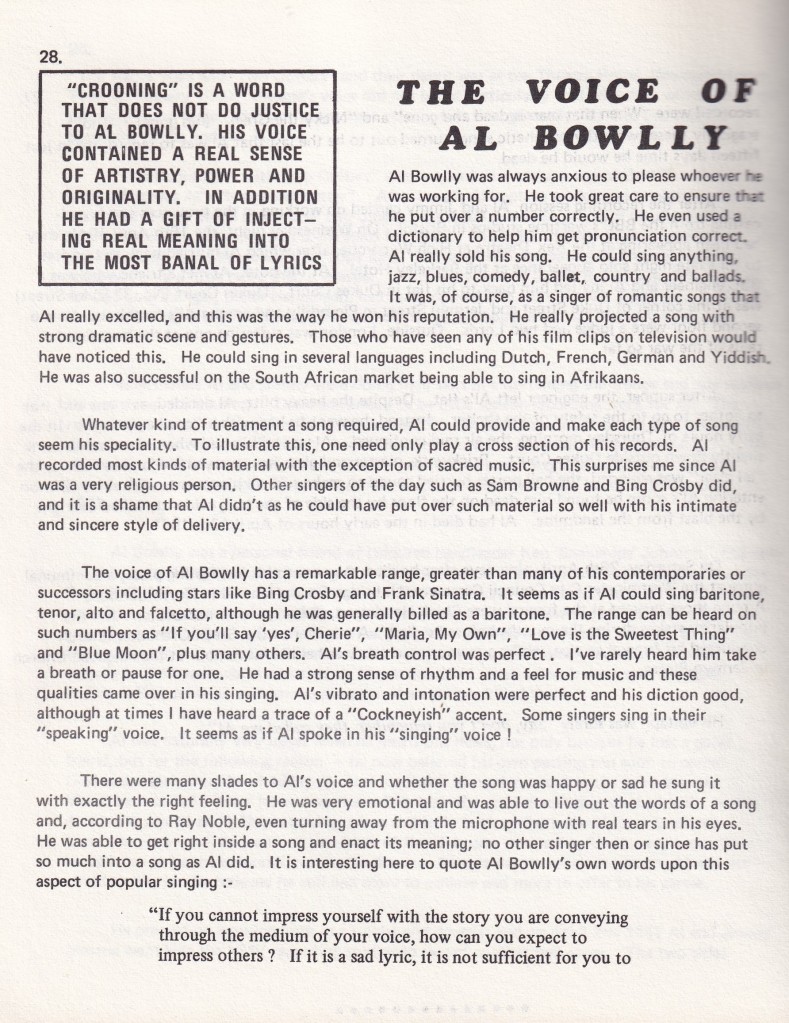
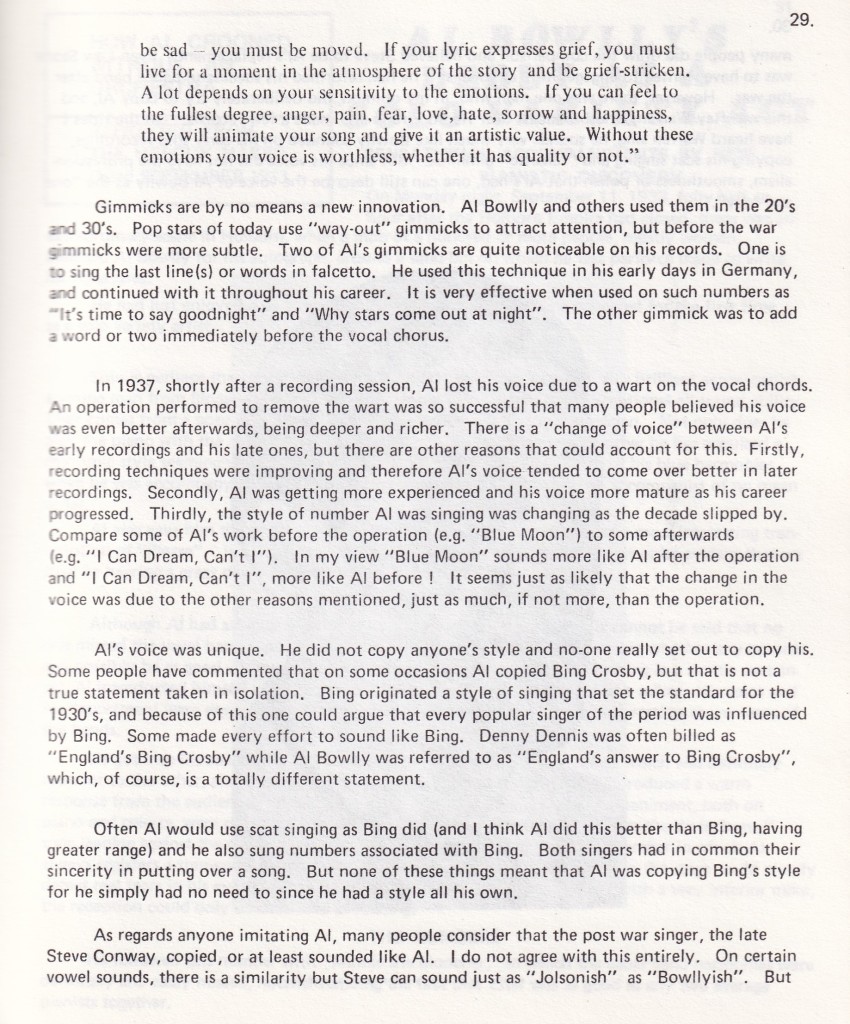
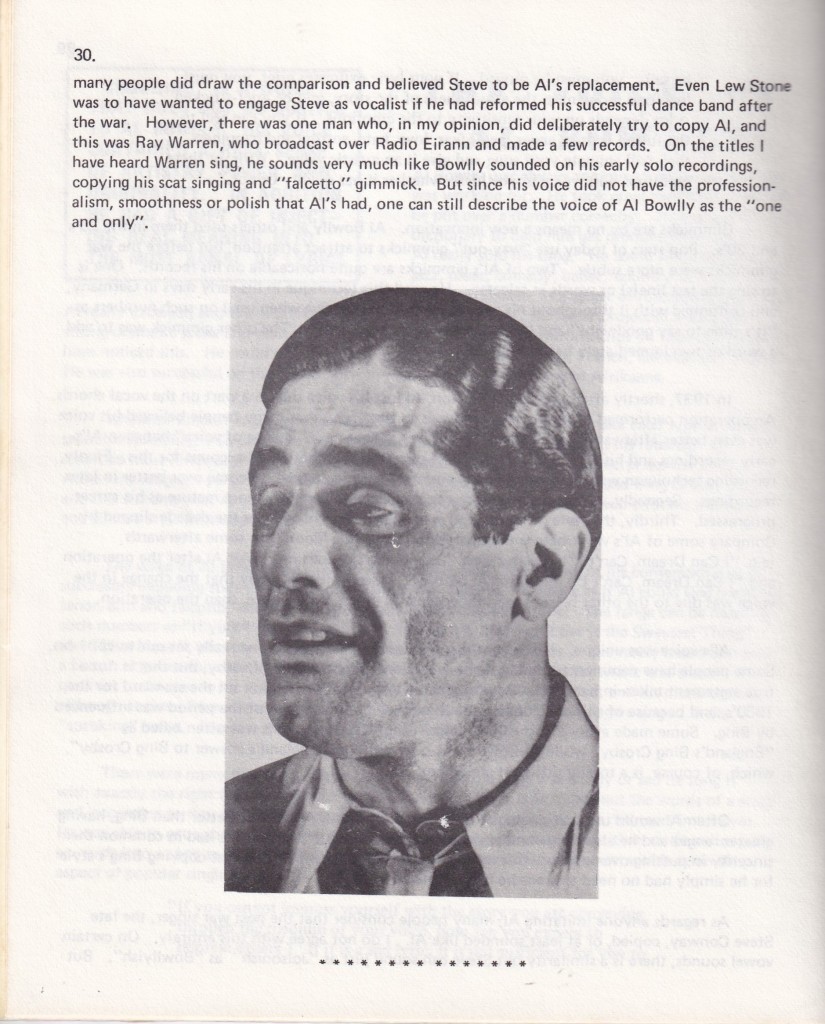
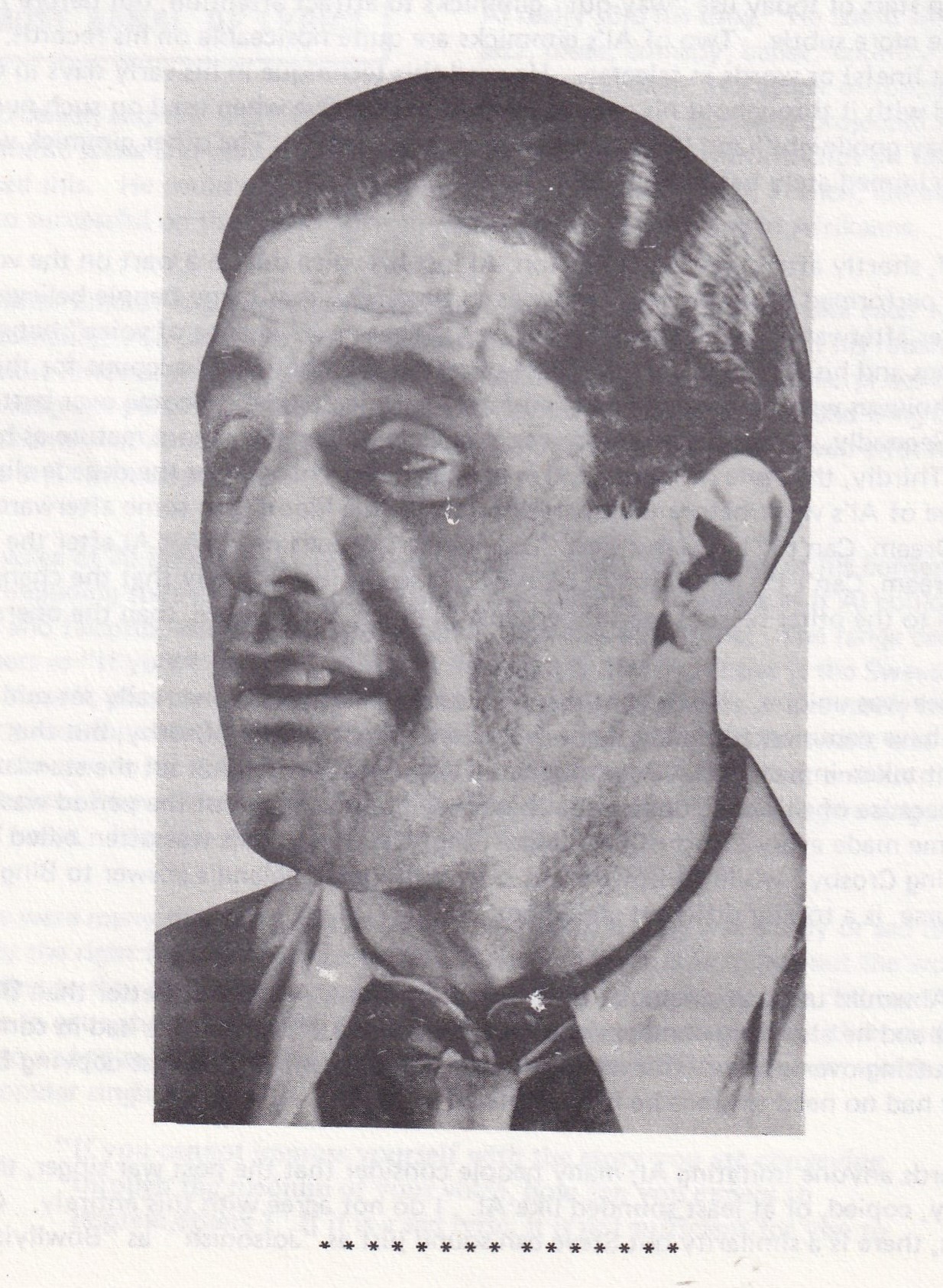
Thank you for posting this. I’m very interested in Al’s voice, not just for the sheer pleasure of listening to him but also the voice theory side of it.
There’s some points Ray made that I’d like to comment on:
“The voice of Al Bowlly has a remarkable range, greater than many of his contemporaries or successors including stars like Bing Crosby and Frank Sinatra . It seems as if Al could sing baritone tenor, alto and falsetto, although he was generally billed as a baritone.”
Oh yes, it’s very apparent that Al had tremendous range! The song that demonstrates this the most is “You Opened My Eyes.” His voice is so powerful and verging on the operatic on this recording. I was blown away when I first heard this song last week! This recording alone shows he was a master at song styling- which is how he liked to describe himself. A “song stylist” not a “crooner” and I fully agree with him. He put his whole heart into this song. His voice is perfection in every way.
I also agree with Ray that Al was way ahead of Crosby and Sinatra. Al is simply the best male singer of the twentieth century and remains unsurpassed today, and never will be equalled never mind surpassed.
I would say though that his most usual range he used in his songs is tenor, but he could reach all the ranges! This is really quite special. Few singers can reach all the ranges.
I’d love to know how many octaves he could sing.
“Al’s breath control was perfect . I’ve rarely heard him take a breath or pause for one.”
I’ve never heard him take a breath and I listen to him on headphones quite often where one can hear that easier than on external speakers. Contrast this with so called celebrated singers today who can be heard loudly breathing in and out throughout their songs!
“He had a strong sense of rhythm and a feel for music and these qualities came over in his singing. Al’s vibrato and intonation were perfect.”
Goodness yes, and some of the rhythms were tricky such as on “If I Had You.” I love how expertly he used vibrato and his intonation is excellent.
“He was able to get right inside a song and enact its meaning; no other singer then or since has put so much into a song as Al did. ”
Absolutely true! His voice is a gift to the world.
LikeLike